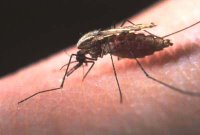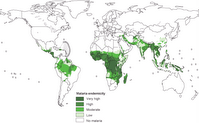 That's the title of Andrew Klein's very interesting article that we came across back in July. What intrigued us most was the lead paragraphs of Klein's article, which outline the promise of research led by the National Institute of Health's David Smith, the results of which were published in the November 24, 2005 edition ($$$) of Nature:
That's the title of Andrew Klein's very interesting article that we came across back in July. What intrigued us most was the lead paragraphs of Klein's article, which outline the promise of research led by the National Institute of Health's David Smith, the results of which were published in the November 24, 2005 edition ($$$) of Nature:
Scientists have created a mathematical formula that could improve malaria treatment by accurately predicting which populations are most vulnerable to the disease, which kills 1.3 million people, mostly children, annually.
The formula could help to focus anti-malarial drugs and preventative treatments on those who need them most by identifying and targeting high-risk groups. This would eliminate the need for blanket treatment of large populations, a process that wastes scarce resources and runs the risk of increasing resistance to anti-malarial drugs.
 This potential improvement in the treatment of malaria is extremely important, since the NIH's researchers determined that 20% of the children studied contracted 80% of all the malarial infections. By focusing on those most likely to be especially vulnerable to infection though mosquito bites, malaria might be much better controlled today and in the future.
This potential improvement in the treatment of malaria is extremely important, since the NIH's researchers determined that 20% of the children studied contracted 80% of all the malarial infections. By focusing on those most likely to be especially vulnerable to infection though mosquito bites, malaria might be much better controlled today and in the future.
The formula considers the relationship between the Parasite Ratio, the proportion of people who are infected with Plasmodium falciparum, the parasite that causes malaria, and the rate at which people are bitten by parasite-carrying mosquitoes (called the Entomological Inoculation Rate.) Compared to previous attempt to model the relationship between these two factors, the new formula closely models observed rates of infection in affected populations. The following figure from Nature illustrates the relationship between the Parasite Ratio (PR) and the Entomological Inoculation Rate (EIR) in the formula (the central curve is defined by the formula):

If you're a regular visitor to Political Calculations, you already know where this is going, as our latest tool does the math put forward by the NIH's researchers! Health researchers and epidemiologists need only to enter the Entomological Inoculation Rate to find the corresponding Parasite Ratio for a given population:
EIR to PR Calculation
The paper published by Smith et al in Nature informs us that the Entomological Inoculation Rate is rarely recorded in Africa, while the Parasite Ratio is a widely measured index of infection risk. Because of these facts, we thought it might also be useful to make a tool to find the Entomological Inoculation Rate given only the Parasite Ratio, which follows below:
PR to EIR Calculation
As a final note, the formula can be used to find the amount of benefit, as measured by a lower Parasite Ratio (PR), that can be achieved by taking steps to reduce the Entomological Inoculation Rate (EIR) for the affected populations:
In quantitative terms, reducing EIR from 200 to 100 and then to 50 would reduce PR by 4% and then by an additional 5%.
 Blanket treatment, as is often the practice in regions afflicted by malaria, would make these benefits prohibitively expensive to achieve. By instead focusing malaria control efforts aimed at reducing the EIR by targeting those most susceptible to infection, scarce resources could be better applied and substantially more lives saved – all through the magic of math!
Blanket treatment, as is often the practice in regions afflicted by malaria, would make these benefits prohibitively expensive to achieve. By instead focusing malaria control efforts aimed at reducing the EIR by targeting those most susceptible to infection, scarce resources could be better applied and substantially more lives saved – all through the magic of math!
Update: Reuters reports that malaria may be facilitating the spread of AIDS in sub-Saharan Africa. If the researchers' findings hold up, this report suggests that Emily Oster's proposal for reducing the spread of AIDS in Africa by focusing on other sexually-transmitted diseases might have a more "mainstream" disease to include in the list of conditions to target (one with the benefit of carrying less potential stigma for those who might not seek treatment otherwise).
Labels: health, health care, math, medicine, tool
Welcome to the blogosphere's toolchest! Here, unlike other blogs dedicated to analyzing current events, we create easy-to-use, simple tools to do the math related to them so you can get in on the action too! If you would like to learn more about these tools, or if you would like to contribute ideas to develop for this blog, please e-mail us at:
ironman at politicalcalculations
Thanks in advance!
Closing values for previous trading day.
This site is primarily powered by:
CSS Validation
RSS Site Feed
JavaScript
The tools on this site are built using JavaScript. If you would like to learn more, one of the best free resources on the web is available at W3Schools.com.